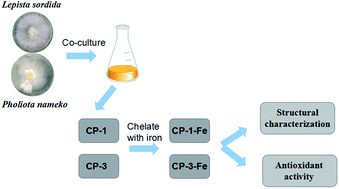Co-cultured Lepista sordida and Pholiota nameko polysaccharide-iron(iii) chelates exhibit good antioxidant activity†
Abstract
In the present study, the structural characteristics and antioxidant activities of polysaccharide from the co-cultured Lepista sordida and Pholiota nameko and its polysaccharide-iron(III) chelates were determined. Two polysaccharide fractions named CP-1 and CP-3 were isolated previously from polysaccharide of the fermentation liquid of the co-cultured Lepista sordida and Pholiota nameko. And their chemical structures were measured by FT-IR infrared spectroscopy, TG analysis, X-ray diffraction and 1H NMR spectroscopy. The results suggested that polysaccharides were chelated with iron(III) by –OH and –COOH groups, forming a stable structure of β-FeOOH and improving crystallinity. Furthermore, the antioxidant activities of polysaccharide-iron(III) chelates exhibited stronger hydroxyl radical and superoxide radical scavenging activity than the polysaccharides. Therefore, the polysaccharide-iron(III) chelates could be used as a potential iron supplement.

- This article is part of the themed collection: 2020 RSC Advances HOT Article Collection


 Please wait while we load your content...
Please wait while we load your content...